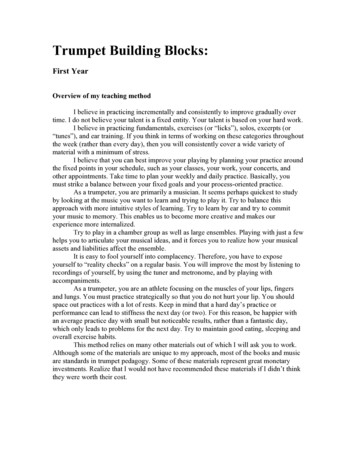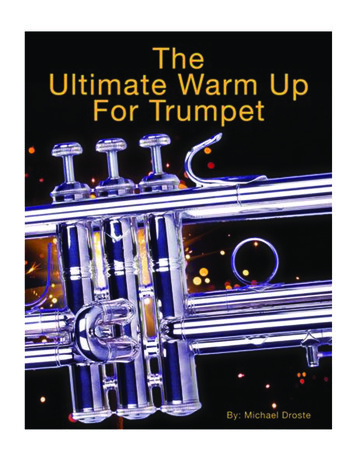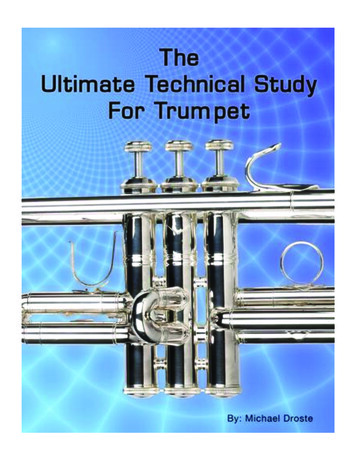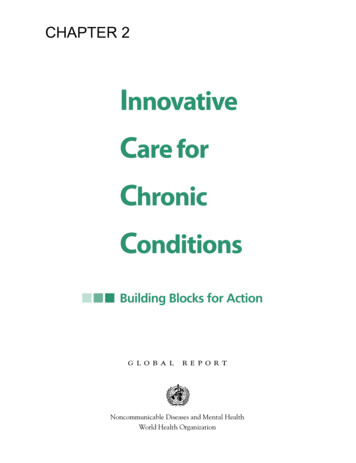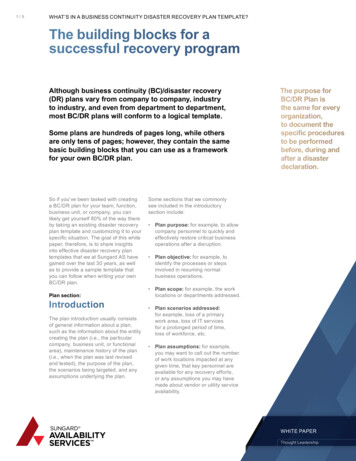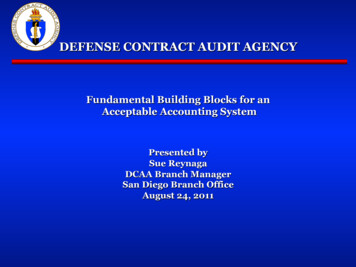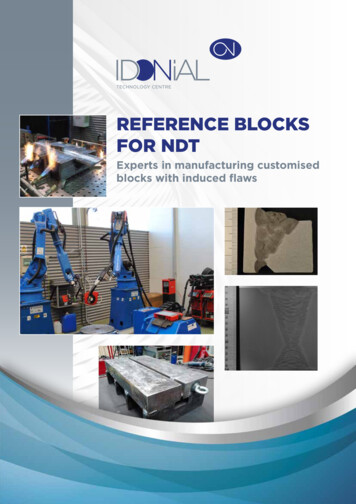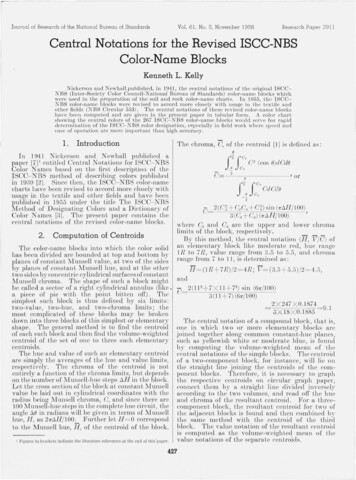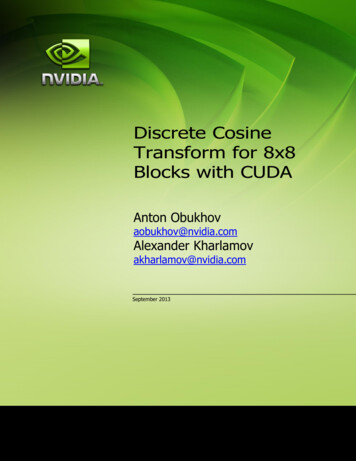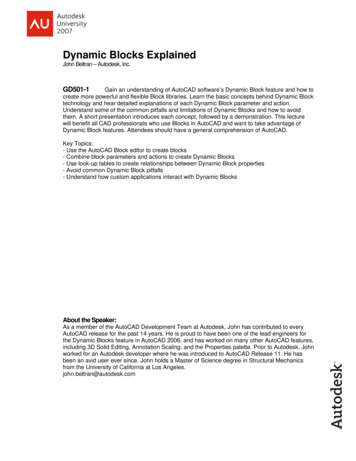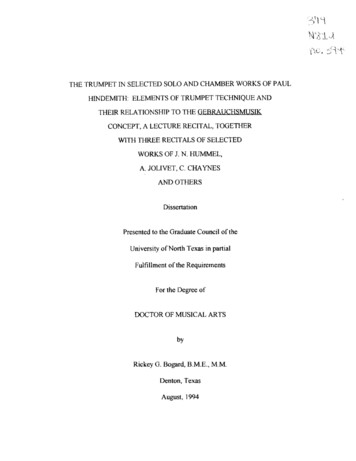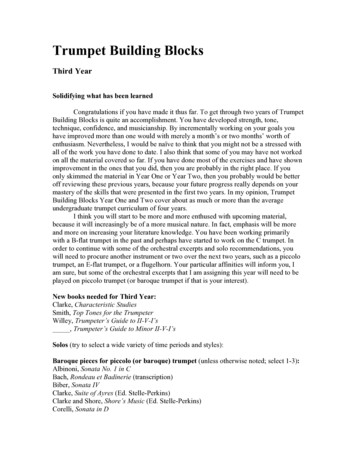
Transcription
Trumpet Building BlocksThird YearSolidifying what has been learnedCongratulations if you have made it thus far. To get through two years of TrumpetBuilding Blocks is quite an accomplishment. You have developed strength, tone,technique, confidence, and musicianship. By incrementally working on your goals youhave improved more than one would with merely a month’s or two months’ worth ofenthusiasm. Nevertheless, I would be naïve to think that you might not be a stressed withall of the work you have done to date. I also think that some of you may have not workedon all the material covered so far. If you have done most of the exercises and have shownimprovement in the ones that you did, then you are probably in the right place. If youonly skimmed the material in Year One or Year Two, then you probably would be betteroff reviewing these previous years, because your future progress really depends on yourmastery of the skills that were presented in the first two years. In my opinion, TrumpetBuilding Blocks Year One and Two cover about as much or more than the averageundergraduate trumpet curriculum of four years.I think you will start to be more and more enthused with upcoming material,because it will increasingly be of a more musical nature. In fact, emphasis will be moreand more on increasing your literature knowledge. You have been working primarilywith a B-flat trumpet in the past and perhaps have started to work on the C trumpet. Inorder to continue with some of the orchestral excerpts and solo recommendations, youwill need to procure another instrument or two over the next two years, such as a piccolotrumpet, an E-flat trumpet, or a flugelhorn. Your particular affinities will inform you, Iam sure, but some of the orchestral excerpts that I am assigning this year will need to beplayed on piccolo trumpet (or baroque trumpet if that is your interest).New books needed for Third Year:Clarke, Characteristic StudiesSmith, Top Tones for the TrumpeterWilley, Trumpeter’s Guide to II-V-I’s, Trumpeter’s Guide to Minor II-V-I’sSolos (try to select a wide variety of time periods and styles):Baroque pieces for piccolo (or baroque) trumpet (unless otherwise noted; select 1-3):Albinoni, Sonata No. 1 in CBach, Rondeau et Badinerie (transcription)Biber, Sonata IVClarke, Suite of Ayres (Ed. Stelle-Perkins)Clarke and Shore, Shore’s Music (Ed. Stelle-Perkins)Corelli, Sonata in D
Corelli, Sonata VIII (for B-flat trumpet; transcription)Fantini, any of his various sonatas (can be played on C trumpet, piccolo, or baroquetrumpet)Fasch, Concerto in DGreene—Boyce, A Suite of Trumpet VoluntariesHaendel & His Contemporaries, A Suite of Trumpet VoluntariesHandel/Fitzgerald, Aria con variazioni (for B-flat trumpet)Krebs, The Six Chorale Preludes (Six short movements, numbers 1, 3, 4, 6 of which areplayable on a C modern trumpet, 2 and 5 are very high and work much better on piccolo)Mouret, Fanfares pour de trompettesMozart, L., Concerto in DStanley, Suite No. 1 of Trumpet VoluntariesTartini, Concerto (requires piccolo; transcription)Telemann, Air de Trompette (can be played on B-flat trumpet)Telemann, Concerto (No. 1) in DTelemann, Heroic Music (transcription, for C or Bb trumpet)Purcell, Sonata (requires piccolo)Purcell, Suite, (Ed. Stelle-Perkins)Torelli, Sonata in D (the so-called “Etienne Roger”)Torelli, Concerto, G. 1Viviani, Sonata 1 or 2Short pieces (select l-3):Alary, Morceau de ConcoursArutunian, Theme and Variations (this is a long piece, similar to a concerto)Arutunian, Concert ScherzoBennett, Rose VariationsBerdiev, ElegyBerghmanns, La ChenilleBitsch, FantasiettaBoehme, Ballet SceneBloch, ProclamationBonneau, Fantasie concertanteBonneau, SuiteBozza, BadinageBozza, CapriceBozza, LiedBozza, RustiquesBrandt, Concert PieceBroughton, ExcursionsBroughton, Oliver’s BirthdayBroughton, FolksongBernstein, Rondo for LifeyBusser, H., Andante et AllegroChance, CredoCharlier, Solo de concours
Copland, Quiet City (need English horn also)Curnow, Concert PieceDefaye, SonatineEnesco, LegendEwazen, Ballade for a CeremonyEwazen, Prayer and PraiseGabaye, BoutadeGoeyens, Al’AnticaGoeyens, Introduction et ScherzoHartley, SonatinaHonegger, IntradaIbert, ImpromptuIves/Bilger, Variations on AmericaKoetsier, SonatinaKreisler, A. von, SonatinaKupfermann, 3 IdeasLatham, SuitePeasley, Night Songs (flugel and B-flat trumpet)Persichetti, The HollowmenPlog, Animal Ditties I and II (need narrator)Ponchielli, ConcertoSachse, Concertino in E-flatSchickele, Three Uncharacteristic PiecesShchedrin, Spanish DanseShostokovich, Fantastic Danses (this may have to be taken from a violin transcription ofthe original piano solo version; it is recorded by Harjanne and Dokshitser)Suderburg, Chamber Music VII and Chamber Music VIIISuppe, DivertissementSutermeister, Gavotte de ConcertTurrin, CapriceTurrin, ElegyTurrin, Escapade (piccolo)Turrin, Four MiniaturesTurrin, IntradaTurrin, Two PortraitsWalker, SonatinaWeber, F. D. Variations in FOne of these concerti (select 1):Arutunian, Concerto (B-flat trumpet)Boehme, Concerto in f-minor (B-flat trumpet or cornet—original was for cornet in A)Chaynes, Concerto (C trumpet)Desenclos, Incantation, Threne, et Danse (technically not a concerto)Giannini, Concerto (B-flat trumpet)Goedick, Concerto (B-flat trumpet)
Gregson, Trumpet Concerto (B-flat trumpet)Haydn, Concerto in E-flat (works for B-flat or E-flat trumpet)Hummel, Concerto in E-flat (works for B-flat or E-flat trumpet)Jolivet, Concertino and Concerto No. 2 (C trumpet for both)Lovelock, Concerto (B-flat trumpet)Stephenson, Concerto (C trumpet)Tull, Concerto No. 2 (B-flat trumpet)Sonatas (select 1):Casterede, Sonatine (C trumpet)Davies, Sonata (D trumpet—very hard)Dello Joio, Sonata (B-flat trumpet)Erb, Sonatina (B-flat trumpet)Ewazen, Sonata (B-flat trumpet)Francaix, Sonatine (C trumpet)Kennan, Sonata (B-flat trumpet)Peeters, Sonata (B-flat trumpet)Stevens, Sonata (B-flat or C trumpet)Stephenson, Sonata (C trumpet)“Show stoppers” or encore pieces (select 1):An Arban cornet soloBach, V., Hungarian MelodiesBellstedt, Carmen FantasyBellstedt, NapoliA Clarke cornet soloDinicu, Hora StacattoGoedicke, Concert EtudeLlewellyn, My RegardsMonti, CzardasUnaccompanied pieces (select 1):Campo, TimesCarter, Retracing IIICheetham, ConcoctionsFriedman, SolusKetting, IntradaOtt, Three Little Pieces for Trumpet and TapePersichetti, ParableTull, EpisodesTull, ProfilesWhittenberg, Polyphony for Solo C Trumpet
Organ-accompanied and other-accompanied pieces (consider one of these if you havean opportunity to program this ensemble type):Bolling, Toot Suite (Six movements: I: C trumpet; II: E-flat trumpet; III: B-flat cornet;IV: B-flat piccolo; V: Flugel; VI: B-flat piccolo. Pick one to three movements. Add drumset and bass to jazz piano for more of a jazz combo feel)Eben, Okna (C trumpet and organ)Plog, 4 Themes on Painting of Edvard Munch (C trumpet and organ)Sowerby, Fantasy (B-flat trumpet and organ)Tomasi, Variations Gregoriennes (works well on E-flat or piccolo with organ)any chamber piece (quintet, quartet, trio, mixed instrumentation)Week 1To be the best musician—and trumpeter—it is important to know yourself,because when we perform, the music should ideally spring from our true voice. To knowwhat that voice is saying, we have to spend significant time with ourselves. As in pastTrumpet Building Blocks, I still advocate keeping a journal. A journal is the mostimportant tool you have for self-examination—for knowing who we really are and whatour true likes and dislikes, strengths and weaknesses are. The other tool for selfknowledge in trumpet playing is the recording device. I would try printing out TBB onone-sided paper, allowing you to write on the opposite blank side and to write in themargins of the printed side (metronome markings, impressions, self-congratulatoryremarks, etc). This also makes it easy to keep up with your blocks of practice—simplycross out what you have done with your pencil or pen.You should expect growth. Consider writing down your goals, and how youbelieve you will obtain them. Richard Cox, in his Performing to the Max, writes that youshould write a personal “oath” which encapsulates your goals. He even advocates readingyour oath to yourself in front of a mirror daily for maximum impact.Assignments:Long tones/Mouthpiece: Mouthpiece: Buzzing CD to track 28 (1 block—same as last semester. Varyarticulations. Vocalize.) Long tones: Gordon, Week 29, part I, II (3 blocks). Smith, Top Tones for Trumpeters, Preparatory Embouchure Studies(“TTTP”), #1 (C)Minute Drills: Single Tongue 112; K Tongue 106 (3 blocks each); or, as an alternative,revisit the Shuebruk Complete Tongue Trainers at the tempos above.Technical I: Colin, Lip Flexibilities, #18-21 (“CLF”; 2 blocks); Gekker ArticulationStudies (“GAS”; work on #13, alternate between the three styles (legato, staccato,marcato; 1 block)Technical II: Willey, Scale Force, p. 75. All Technical Studies, key of C, church modes.(4 blocks).
Technical Literature I: Sachse transposition etudes #42 (“ET”; 1 block); Smith TopTones for Trumpeters (“TTT”), Etude #1 (3 blocks). Clarke, CharacteristicStudies (“CCS”), #1 (as per Gordon’s suggestion in Lesson 29, part V; 2 blocks).Technical Literature II:Orchestral Excerpts: Bach, Magnificat (this is the first baroque orchestral excerpt that Ihave assigned in the TBB series; you will want to work on this with a piccolotrumpet [or, a baroque trumpet]; 2 blocks)Jazz licks, We will be exploring Willey’s Trumpeter’s Guide to II-V-I’s (“Wii-v”) andTrumpeter’s Guide to Minor II-V-I’s (“WMii-v”). In both books, learn patterns onp. 13 (read about the pattern in Section One, learn in all 12 keys; 2 blocks)Literature: Solo of choice, and Clarke’s Bride of the Waves (p. 37 of Clarke’sCharacteristic Studies). 3 blocks.Ear Training: Transcribe a solo by ear (“T”; classical or jazz; this can be also the solothat you are working on currently if it is classical; 3 blocks)Suggested Week 1 schedule—you plan your own practiceDay1Day2L/MPCG29,I, IIMP to28MDTech IST112, CLFKT106 #18-21Day3CG29,I, IIST, KTGAS#13Day4Day5Day6CG29,I, IITTTP(C)CLF#18-21ST, KTTech IITech Lit IET 42; TTT1;CCS1WSF p. 75 (C);church modes; iiiWSF p. 75;church modes;iii-ivWSF p. 75;TTT1church modes;v-viTTT1WSF p. 75;church modes;viiCCS1Tech Lit IIO: BachMagnificatLitEarTS (choice)L: Wii-v &WMii-v, 13S (Clarke,Bride)TOTL, OSDay7Week 2You cannot succeed if you do not prepare enough. You cannot “psych” yourselfinto a great performance without adequate work. Be fit in general with yourfundamentals. Fundamentals are so vast in scope that you cannot expect to conquer themwithout extensive organization (hence Trumpet Building Blocks). Be specificallyprepared in your repertoire—with quality controls (how many times through perfectlycan you play it?).Remember also that the trumpet is an extension of your personality and personalstrengths and weaknesses. Work on your confidence in general by constantly expanding
your comfort zone. Eliminate general excuses and do not blame others for yourshortcomings (a journal is a great place to work this sort of thing out).Assignments:Long tones/Mouthpiece: Mouthpiece: Buzzing CD to track 28 (1 block—same as last semester. Varyarticulations. Vocalize.) Long tones: Gordon, Week 29, part I, II (repeat; 3 blocks). Smith, Top Tones for Trumpeters, Preparatory Embouchure Studies(“TTTP”), (up to key of C)Minute Drills: Single Tongue 112; K Tongue 106 (3 blocks each); or, as an alternative,revisit the Shuebruk Complete Tongue Trainers at the tempos above.Technical I: Colin, Lip Flexibilities, #18-21 (“CLF”; 2 blocks); Gekker ArticulationStudies (“GAS”; work on #14, alternate between the three styles (legato, staccato,marcato; 1 block)Technical II: Willey, Scale Force, p. 75. All Technical Studies, key of C, AMM modes.(4 blocks).Technical Literature I: Sachse transposition etudes #43 (1 block); Smith Top Tones forTrumpeters (“TTT”), Etude #2 (3 blocks). Clarke, Characteristic Studies(“CCS”), #1 (as per Gordon’s suggestion in Lesson 29, part V; 2 blocks).Technical Literature II:Orchestral Excerpts: Bach, Magnificat (repeat; 2 blocks)Jazz licks, We will be exploring Willey’s Trumpeter’s Guide to II-V-I’s (“Wii-v”) andTrumpeter’s Guide to Minor II-V-I’s (“WMii-v”). In both books, learn patterns onp. 14 (read about the pattern in Section One, learn in all 12 keys; 2 blocks)Literature: Solo of choice, and Clarke’s Bride of the Waves (repeat; p. 37 of Clarke’sCharacteristic Studies). 3 blocks.Ear Training: Transcribe a solo by ear (“T”; classical or jazz; this can be also the solothat you are working on currently if it is classical; 3 blocks)Suggested Week 2 schedule—you plan your own practiceDay1Day2Day3Day4Day5Day6Day7L/MPCG29,I, IIMP to28MDTech IST112, CLFKT106 #18-21CG29,I, IIST, KTCG29,I, IITTTP(C)Tech IITech Lit IET 43; TTT2;CCS1Tech Lit IIO: BachMagnificatWSF p. 75 (C);AMMs; i-iiGAS#14WSF p. 75;AMMs; iii-ivWSF p. 75;AMMs; v-viCLF#18-21ST, KTLitS (choice)TTT2L: Wii-v &WMii-v, 14OS (Clarke,Bride)TTT2WSF p. 75;AMMs; viiEarTCCS1TTL, OS
Week 3Do you take mental pictures of your performances (and other life events)? Do youfocus your mental camera on negative aspects of your performance and save thoseimages for you mental profile of yourself? Do yourself a favor—delete those images thatare negative and are seriously entertained by your brain. It is okay to have negativeimages if they are only thought of to remind you of your sense of humor and innocentfallibility. But if they are continual reminders that imprint on your mind as a template forfuture expectations, then you will have to first find these images (hard to do sometimes)and consciously replace these with positive images.Assignments:Long tones/Mouthpiece: Mouthpiece: Buzzing CD to track 28 (1 block—same as last semester. Varyarticulations. Vocalize.) Long tones: Gordon, Week 30, part I, II (3 blocks). Smith, Top Tones for Trumpeters, Preparatory Embouchure Studie
Chaynes, Concerto (C trumpet) Desenclos, Incantation, Threne, et Danse (technically not a concerto) Giannini, Concerto (B-flat trumpet) Goedick, Concerto (B-flat trumpet) Gregson, Trumpet Concerto (B-flat trumpet) Haydn, Concerto in E-flat (works for B-flat or E-flat trumpet) Hummel, Concerto in E-flat (works for B-flat or E-flat trumpet) Jolivet, Concertino and Concerto No. 2 (C trumpet for .
